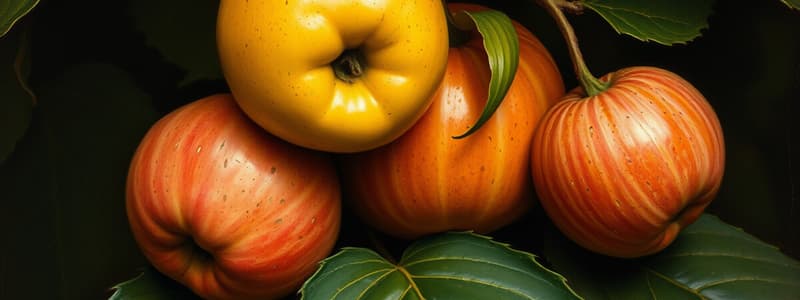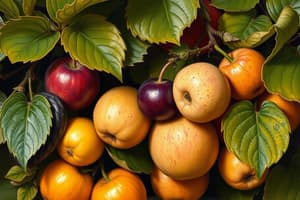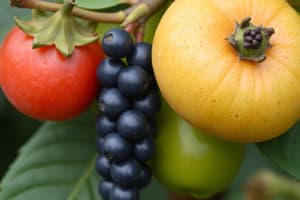Podcast
Questions and Answers
The sperm and egg are a plant's reproductive cells, or ______.
The sperm and egg are a plant's reproductive cells, or ______.
gametes
The fruit of the sandbur uses ______ dispersal.
The fruit of the sandbur uses ______ dispersal.
animal
A fruit that forms from a single flower with several pistils is a(n) ______ fruit.
A fruit that forms from a single flower with several pistils is a(n) ______ fruit.
aggregate
The sweet-tasting, watery liquid produced by the flowers of certain plants is called ______.
The sweet-tasting, watery liquid produced by the flowers of certain plants is called ______.
The part of the embryo that develops into the root system of a plant is the ______.
The part of the embryo that develops into the root system of a plant is the ______.
A fruit consisting of an outer fleshy layer and an inner papery core is called a ______.
A fruit consisting of an outer fleshy layer and an inner papery core is called a ______.
A type of fruit that consists of a small dry seed with one or two wing-like structures is called a __________.
A type of fruit that consists of a small dry seed with one or two wing-like structures is called a __________.
A fruit that has an outer fleshy layer and an inner woody layer is known as a __________.
A fruit that has an outer fleshy layer and an inner woody layer is known as a __________.
A pome is characterized by an outer fleshy layer and an inner papery core, making it a type of __________.
A pome is characterized by an outer fleshy layer and an inner papery core, making it a type of __________.
The part of a plant embryo that develops into the root system is known as the __________.
The part of a plant embryo that develops into the root system is known as the __________.
Flashcards are hidden until you start studying
Study Notes
Fruit Types and Descriptions
- Pome: A fruit type characterized by an outer fleshy layer surrounding a papery core.
- Samara: A type of fruit featuring a small dry seed equipped with one or two wing-like structures facilitating wind dispersal.
- Berry: Defined as a fruit where the entire ovary is fleshy and juicy throughout, lacking a hard stony layer.
- Drupe: This fruit has an outer fleshy layer along with a hard woody inner layer encasing the seed.
Key Biological Concepts
- Gametes: The reproductive cells in plants, including sperm and egg cells.
- Animal Dispersal: A seed dispersal mechanism utilized by plants like sandbur, where seeds attach to animals or clothing to travel to new locations.
- Aggregate Fruit: A type of fruit formed from a single flower that has multiple pistils, resulting in several small fruits clustered together.
- Nectar: A sweet and watery liquid produced by flower structures, attracting pollinators.
- Radicle: The embryonic part of a plant that develops into the root system, crucial for anchoring and nutrient absorption.
Fruit Types and Descriptions
- Pome: A fruit type characterized by an outer fleshy layer surrounding a papery core.
- Samara: A type of fruit featuring a small dry seed equipped with one or two wing-like structures facilitating wind dispersal.
- Berry: Defined as a fruit where the entire ovary is fleshy and juicy throughout, lacking a hard stony layer.
- Drupe: This fruit has an outer fleshy layer along with a hard woody inner layer encasing the seed.
Key Biological Concepts
- Gametes: The reproductive cells in plants, including sperm and egg cells.
- Animal Dispersal: A seed dispersal mechanism utilized by plants like sandbur, where seeds attach to animals or clothing to travel to new locations.
- Aggregate Fruit: A type of fruit formed from a single flower that has multiple pistils, resulting in several small fruits clustered together.
- Nectar: A sweet and watery liquid produced by flower structures, attracting pollinators.
- Radicle: The embryonic part of a plant that develops into the root system, crucial for anchoring and nutrient absorption.
Studying That Suits You
Use AI to generate personalized quizzes and flashcards to suit your learning preferences.




